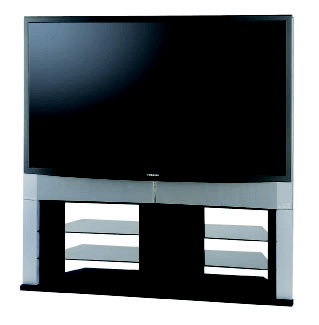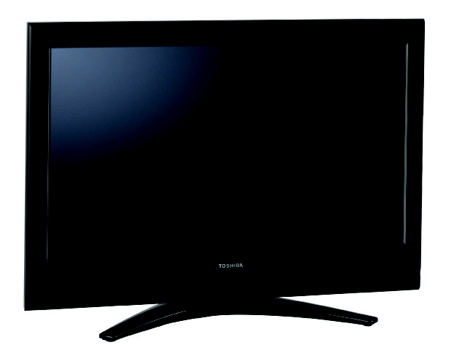Toshiba Goes Coconuts
The company's biggest news this year is already being made by the HD DVD format. While this was hardly ignored at the press address, there was little news on that front. Yes, it was announced that Paramount might be the next studio to release titles on HD DVD. And it was also mentioned that there are talks ongoing with additional hardware manufacturers about producing players. (All of the current players are either Toshiba brand or re-badged Toshiba machines—not a good recipe for the long-term health of the format). But there were no specific dates or titles given on the Paramount releases, and no specifics on other possible hardware providers. And while more players from Toshiba are coming off the boat almost daily, the quantities so far appear to be short of the number required to produce a good inventory at your local Best Buy. That will come, but expect a very tight player market for the foreseeable future.

As for news about any changes to future HD DVD players (such as 1080p output), it's far too early for Toshiba to talk openly about a second generation. In a private discussion with a Toshiba rep, however, I did learn of a future firmware change (no date mentioned) that should clear up the "HDMI Error 0" crash that I occasionally experience on my HD-A1 when switching or disconnecting the HDMI lead. I've found that it may usually be cleared simply by ejecting the disc. If not, I was told that pushing and holding the Power Off button for about 10 seconds resets the system without the need to unplug the player and then plug it in again. But if all else fails, however, the latter should clear the problem.
While HD DVD is certainly big news, it wasn't the main attraction at the show. Toshiba is, first and foremost, a video display manufacturer, and its new line of flat panel displays was front and center. Toshiba has gone to flat panel LCD displays in a big way this year. It now offers a total of 20 LCD sets ranging from 20" to 47" (diagonal), plus two plasmas (42" and 50", both 720p) that were positioned in the rear of the room where they drew little attention.
Most (but not all) of the LCDs sport the sub-brand designation "REGZA." REGZA is a peculiarly Japanese-style acronym that stands for (R)eal (E)xpression (G)enerated by Ama(Z)ing (A)rchitecture. The "architecture" refers to certain aspects of the REGZA design, including Toshiba’s PixelPure Hi-Bit 12-bit digital video processing, CineSpeed LCD Panel technologies, and a 176-degree viewing angle. PurePixel is claimed to provide 16 times the gradation levels of 8-bit systems for a smoother image, and CineSpeed is said to offer a panel response times of 8ms.
In what is bound to be a confusing subdivision of the LCD lineup, some (but not all) of the LCD models are dubbed REGZA. Of those that are, we have plain-jane REGZA, REGZA LCDVD, and REGZA XHD. In addition, there are also both standard and Cinema Series models of REGZA and REGZA XHD.
We'll stick to the REGZA XHD models in this discussion, as their 1080p panels are likely to generate the most buzz. Available in 42" (REGZA XHD) and 42" and 47" (Cinema Series REGZA XHD) sizes, they include NTSC and ATSC/QAM digital tuning, a CableCARD slot, TV Guide On Screen, dual HDMI inputs, and Toshiba's New Native Rate, zero overscan mode. Cinema Series models also feature a high gloss black finish, Toshiba's SoundStrip audio (the sound emanates from a narrow slot below the screen), and the company's ColorMaster color management system, which offers hue, saturation, and brightness adjustments of red, green, blue, yellow, cyan, and magenta.

Toshiba obviously sees flat panels as the wave of the future, but is still very much in the rear projection (microdisplay) business, with nine DLP models ranging from a new, compact 42" (diagonal) design (at 39.25" wide, it's actually smaller than the earlier Toshiba 36" 4x3 televisions) up to the top-of-the-line 72" Cinema Series XHD set. Four of the DLP sets are 1080p models (again, dubbed XHD), with 62" and 72" models in both the XHD and Cinema Series XHD ranges. The latter feature 150W projection lamps, Toshiba's PixelPure 12-bit digital video processing and ColorMaster color management system, Xtreme BLAC (a dynamic iris system for deeper blacks and improved contrast), and convenience features similar to those in the LCD displays.
None of Toshiba's new 1080p sets will accept a 1080p source direct to any input. The only 1920x1080 source they will accept is 1080i.
One topic barely touched on was the status of SED. This Toshiba/Canon flat panel technology, yet to emerge from the labs apart from rare trade show demonstrations, has the potential to blow other flat panel pictures into the weeds if it can be brought to market as a reliable product that is at least marginally competitive with increasingly affordable LCDs and plasmas. As of now, initial SED production is tentatively set for the summer of 2007, with the first shipments at the end of 2007. Based on that information, I'd call it a safe bet that if it does come to market, we won't see it here in the U.S. until sometime in 2008. To those of us who have seen it, that's a long wait.
Pricing and forecast availability (only 1080p models shown, all dates 2006)
LCD
Cinema Series REGZA: 37LX96 ($2,599.99, July)
REGZA XHD: 42", 42HL196 ($2,999.99, July)
Cinema Series REGZA XHD: 42LX196 ($3,299.99, July); 47LX196 ($4,499.99, August)
DLP
XHD: 62HM196 ($3199.99, June); 72HM196 ($4,499, July)
Cinema Series XHD: 62MX196 ($3499.99, July); 72MX196 ($4,799, August)
























































